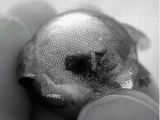A new type of flexible smart textile, developed by researchers Jonathan Engel and Chang Liu at the Micro and Nanotechnology Lab at the University of Illinois, employs interconnecting rings and links, in a fashion similar to the chain mail used by medieval warriors. "We were interested in using microtechnology to build something that could flex and bend. The chain mail construction is nothing fancy, but it's an interesting structure that hasn't been used much recently", said Liu.
Smart fabrics are intelligent devices aimed to be inserted into wearable computer-shirts that can detect vital signs, locate bullet wounds, or give an information network for soldiers on a dispersed battleground.
Most smart fabrics researches focus on incorporating electronic elements into conventional textiles, but the new type is a breakthrough: an integrated circuit as the fabric itself is a continuous, flexible and elastic metallic textile with many electrical and mechanical properties.
The micro-chain mail can bend along two axes, permitting the cloth to drape over surfaces that are not plain without producing wrinkles, a quality determined by the web of copper mini-rings, each roughly 0.5 mm in length, interconnected by links, that are able to slide and rotate against each other.
When the fabric is stretched, it can expand by 32%, while its width lowers by 56%. "The flexible fabric can conform to curved surfaces, and be used on objects that move. Because of the nature of the fabric, electronics can be easily integrated into the technology. In the future, for example, this type of clothing could shield electromagnetic waves for construction workers", explained Liu.
Experiments showed that the displacement of the rings induced variations in its electrical conductivity, and when the fabric was fully extended, at the maximum electrical contact, electrical resistance lowered by seven orders of magnitude, thus the material could be employed as an electrical device. The mechanical tensile strength of the fabric was found to be less than half of the copper's strength.
Broke-failure tests showed that mostly the rings rather than the links cracked, different from what occurs with the normal copper. The researchers made their first material employing a multilayer microelectroplating technique, storing thin coatings of aluminum, copper and photoresist on a substrate to get a mold for the copper.
The smart fabric could be made of other materials, too, like silicon, whose chain mail fabric could produce power employing solar cells, or track down motion or strain while a fabric based on polymer elastomers could detect chemicals, strain or pressure. "This is just one of the first steps in wearable electronics technology. The long-term interest is to make computer gear blend in to everyday clothing so that it doesn't feel intrusive. This is a barrier for people for wearing, for example, solar cells or sensors on their clothing, but it can be overcome by a robust fabric that moves with you." said Liu.
Image credit: Engle et al

 14 DAY TRIAL //
14 DAY TRIAL // 
